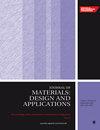Enhancing crashworthiness characteristics of modified hexagonal honeycomb structural panels through stretching and bending of ribs
IF 2.2
4区 材料科学
Q3 MATERIALS SCIENCE, MULTIDISCIPLINARY
Proceedings of the Institution of Mechanical Engineers, Part L: Journal of Materials: Design and Applications
Pub Date : 2024-04-09
DOI:10.1177/14644207241245857
引用次数: 0
Abstract
The effects of stretching and bending of concave, convex, and horizontal ribs on the energy absorption characteristics of modified hexagonal honeycomb structural panels are investigated under in-plane quasi-static compression loading conditions. In this regard, five hierarchical modified structural panel configurations were fabricated using polylactic acid material (PLA) via a fused filament 3D printer, ensuring uniform wall thickness in the 1.5–2 mm range. The panels included the regular hexagonal panel (RHP), regular hexagonal panel with concave rib (RHCP), regular hexagonal panel with convex rib (RHXP), regular hexagonal panel with concave and horizontal ribs (RHCRP), and regular hexagonal panel with convex and horizontal ribs (RHXRP). In-plane quasi-static compressive loading tests were conducted to analyze crush resistance characteristics, and buckling modes of the modified honeycomb panels were examined through experimental and finite element analysis procedures. The result indicates that the specific energy absorption capacity (SEA) of RHXRP is increasing significantly compared to the SEA capacity of other categories of the structures. The changes in failure modes and increased crush energy absorption characteristics of modified RHP with the introduction of concave, convex, and horizontal ribs are elaborated.通过拉伸和弯曲肋条提高改性六边形蜂窝结构板的防撞性能
研究了在平面准静态压缩加载条件下,凹肋、凸肋和水平肋的拉伸和弯曲对改性六边形蜂窝结构板能量吸收特性的影响。为此,使用聚乳酸材料(PLA)通过熔丝三维打印机制造了五种分层改性结构板配置,确保壁厚在 1.5-2 毫米范围内均匀一致。这些面板包括常规六边形面板(RHP)、带凹棱的常规六边形面板(RHCP)、带凸棱的常规六边形面板(RHXP)、带凹棱和水平棱的常规六边形面板(RHCRP)以及带凸棱和水平棱的常规六边形面板(RHXRP)。通过实验和有限元分析程序,对改性蜂窝板进行了平面准静态压缩加载试验以分析其抗挤压特性,并研究了其屈曲模式。结果表明,与其他类别结构的比能量吸收能力相比,RHXRP 的比能量吸收能力显著提高。此外,还阐述了引入凹肋、凸肋和水平肋后,改良 RHP 的失效模式发生的变化以及挤压能量吸收特性的提高。
本文章由计算机程序翻译,如有差异,请以英文原文为准。
求助全文
约1分钟内获得全文
求助全文
来源期刊

CiteScore
4.70
自引率
8.30%
发文量
166
审稿时长
3 months
期刊介绍:
The Journal of Materials: Design and Applications covers the usage and design of materials for application in an engineering context. The materials covered include metals, ceramics, and composites, as well as engineering polymers.
"The Journal of Materials Design and Applications is dedicated to publishing papers of the highest quality, in a timely fashion, covering a variety of important areas in materials technology. The Journal''s publishers have a wealth of publishing expertise and ensure that authors are given exemplary service. Every attention is given to publishing the papers as quickly as possible. The Journal has an excellent international reputation, with a corresponding international Editorial Board from a large number of different materials areas and disciplines advising the Editor." Professor Bill Banks - University of Strathclyde, UK
This journal is a member of the Committee on Publication Ethics (COPE).
 求助内容:
求助内容: 应助结果提醒方式:
应助结果提醒方式:


